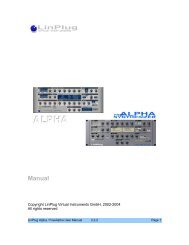Alpha Series User Manual - LinPlug Virtual Instruments
Alpha Series User Manual - LinPlug Virtual Instruments
Alpha Series User Manual - LinPlug Virtual Instruments
Create successful ePaper yourself
Turn your PDF publications into a flip-book with our unique Google optimized e-Paper software.
Glossary<br />
AM: AM or "Amplitude Modulation" is a process where the amplitude of one<br />
generator (the carrier) is controlled by another (the modulator). When the frequency<br />
of the modulator is periodic and below the audio range (less than 20 Hz) tremolo is<br />
produced. When the modulation frequency is within the audio range, Ring<br />
Modulation is produced. See also Ring Modulation below.<br />
Amplifier: A signal processing device that changes the amplitude, and hence the<br />
volume, of a signal.<br />
Envelope: A time-varying signal used to control the development of another signal<br />
after it has been triggered. Envelopes are most often used for controlling a signal's<br />
amplitude. The shape of the envelope is determined by the number of control<br />
parameters. Usually four parameters are available: Attack Time, Decay Time,<br />
Sustain Level and Release Time.<br />
Filter: A signal processing device that suppresses or "filters" out specific parts of a<br />
signal's frequency spectrum. Numerous types of filter are used in audio synthesis.<br />
These include Low Pass, High Pass, Band Pass and Notch. The tone controls on a<br />
stereo amplifier are one example of an audio filter.<br />
LFO: An LFO or "Low Frequency Oscillator" is a periodic signal source (usually<br />
below audio frequency range) used to modulate another signal parameter. An LFO<br />
can be used for a variety of effects including vibrato (by modulating the pitch) and<br />
tremolo (by modulating the volume).<br />
Modulation Matrix: A signal "junction" where a source signal can be patched so that<br />
it controls a destination signal. The <strong>Alpha</strong>'s Modulation Matrix is used for tasks such<br />
as modulating an oscillator's amplitude by an LFO.<br />
Oscillator: A signal source that generates a periodic waveform at a given frequency.<br />
Ring Modulation: The process of combining two audio signals by multiplication.<br />
Ring Modulation produces sidebands but suppresses both the carrier and<br />
modulating frequencies. Though Ring Modulation is only a special form of AM, in<br />
practice “AM” is considered Ring Modulation plus the carrier (one of the oscillators, in<br />
<strong>Alpha</strong> its the oscillator 2) and “Ring Modulation” is considered pure Ring Modulation<br />
with no carrier.<br />
<strong>LinPlug</strong> <strong>Alpha</strong> <strong>Series</strong> <strong>User</strong> <strong>Manual</strong> 3.0 Page 22












